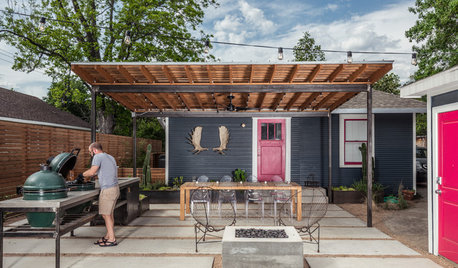When they say the smartest ideas are the simplest, they really mean it....I had never thought of this idea before, but it's truly brilliant in its simplicity.
Regular readers may recall I had to rip out some drywall and make some running repairs to one of the drains from my upstairs bathroom because the moronic former owners of my house had drilled not one, but three shelf bracket screws right through the drain pipe (I wonder if they used a stud finder...and ignored the cleanout directly below)
In a peculiar twist of fate I was looking at BC's "Livesmart" govt website because we are looking at what we can do to reduce our energy bills and take advantage of some of the cash incentives out there, I just happened to see the topic "drain water heat recovery" and immediately I thought "why didn't I think of that?"
It's beautiful in its simplicity yet almost like lifting yourself by your bootstraps. As you are showering, you are running warm water down the drain, and cold (very cold in winter) water is entering the hot water heater to replace it. By this very basic heat transfer idea (it's not even a water jacket, just a copper section of pipe that replaces a section of drain from your main bathroom) you preheat the cold water entering the hot water heater.
In my case, I've already removed the drywall to access the damaged pipe, and hadn't gotten around to redoing it yet, in this instance my procrastination could pay off....
In an even odder twist of fate, I'd been debating whether to just leave the JB weld repair in place, or cut out the section of pipe and replace it. Unless this system is very expensive, I will be replacing that section with this stuff instead.
Like I said, the most brilliant ideas are the simplest. Free energy that is literally going down the drain. All made of copper, ought to outlast the house. Running the line to the hot water heater will be a bit fiddly but there is a - what do you want to call it, a plenum or dropped section of the ceiling where hvac ducting runs, right to my furnace room where the hw heater is, a distance of only ten feet or so. I am thinking I will need to use the bendable copper pipe to run to the recovery unit, so I will be able to feed the pipe through the ceiling owing to the cramped areas. I wonder if lagging the pipe where it returns from the heat recovery would be a good idea. (none of my hot pipes are insulated or lagged, which seems pretty silly. My dad, a retired engineer says the first few feet where the hot water leaves the heater is the most important.)
I'm not sure how dramatic the improvement will be, but copper is a pretty good heat conductor and the heat is basically free, so it's a cumulative benefit..I also like the low-tech aspect of it. I suppose anyone a bit crafty could build something like it themselves even.
Most of this stemmed from my desire to see how people do solar hot water in a climate with subzero temperatures, when I lived in Australia solar hw was slowly taking off, considering electricity is expensive, temps virtually never go below freezing and there is a lot of sunlight, you'd think it a no-brainer. Of course in BC at my latitude, days are very short in winter and I'm not sure how much heat gain you'd get in winter, but the big tradeoff is summer where the sun doesn't set until amost 10pm. I have a great southfacing roof so am in an ideal position for solar, and I found some interesting systems out there. I believe if I went solar I could turn off the gas to the heater for months at a time, and eventually go to a storage tank and on-demand heating which I imagine would be the best way of all.
One manufacturer: http://www.renewability.com/powerpipe.htm and one other link, a Saskatchewan Crown gas corporation, have more info and the Saskenergy lists more manufacturers. Being a crown corporation, we would hope that we can rely on honest, unbiased info. They claim the heat recovery will even stop you from running out of hot water...if that's the case it's even better than I thought...(I am running my heater at a low temp because it was installed with no expansion tank and I haven't gotten round to putting one in yet (yes, I know :"> ) which I need to do, because I have a pressure regulator and therefore, backflow prevention. Now I can add yet another mod to that installation (expansion tank, whole house filter, etc)
What do you all think? It seems like a great idea to me, I'll look at the pricing, which may kindle (or dampen) my enthusiasm further.
Here is a link that might be useful: Sask Energy drainwater heat recovery















ky114
pjb999Original Author
Related Discussions
AC Heat recovery for Hot Water?
Q
hru (heat recovery unit) attached to hvac
Q
Best shower valve for cold water temp fluctuations?
Q
Drain Water Heat Recovery pipe urine corrosion/decay?
Q
ky114
pjb999Original Author
garymunson-2008
garymunson-2008
pjb999Original Author
pjb999Original Author
zl700
pjb999Original Author
pjb999Original Author
ky114
pjb999Original Author
garymunson-2008
zl700
pjb999Original Author
pjb999Original Author